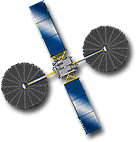Event Shows Need For Better Information Sharing, 'Space
Situational Awareness'
Wednesday's collision of two communication satellites has left a
debris pattern that may affect future space operations, the vice
chairman of the Joint Chiefs of Staff said at a symposium in
Washington, DC co-sponsored by the George C. Marshall Institute and
the US Chamber of Commerce's Space Enterprise Council.

US Marine Gen. James E. Cartwright, speaking on the national
security ramifications of the
collision between an American and a Russian
satellite, said the event shows the need for better
information sharing and space situational awareness.
The American satellite, owned by Iridium Satellite of Bethesda,
MD, weighed about 1,200 pounds and collided with a Russian
satellite that had been nonoperational for more than a decade. The
crash happened 491 miles above Siberia. The collision was confirmed
when the active US satellite did not report in and the debris field
was picked up by sensors.
"My worry is that debris field is going to be up there for about
a year, so we're going to have to play a little bit of dodgeball,"
Cartwright said. "It's going to be a problem because it will take a
month or two for the debris to settle down and for us to understand
the scope of the field to be able to track it and understand where
at least the larger objects are."
The debris will be around for some time because the satellites
were in a high orbit around the earth, Cartwright said. Once the
debris field has stabilized, there will be a pattern that all
countries can use to navigate around, he said.
"It's a field of debris out there that's going to be out there
for many years," he said. "The good news is once it's stabilized,
it's relatively predictable. The bad news is, it's a large area. If
we're denied that large area for use, it becomes a problem."
Many of the commercial and national security satellites,
particularly communications satellites, rely on certain spacing
between other objects in order to be effective, Cartwright said.
Losing a spot because of debris could have a financial or
operational impact on anyone wanting to use the space, he said.
"If that's going to be long term, that's a problem for us," he
said.
 The general said he hopes the
incident will result in a better exchange of satellite orbit data
between countries.
The general said he hopes the
incident will result in a better exchange of satellite orbit data
between countries.
"I'd like to be able to find a way, not only with Russia, but
with other nations to make sure that our exchange of data is more
complete," he said. "We would be remiss to not take advantage of
this and turn it into good."
The growing number of satellites require improved information
sharing, Cartwright said. "It is a crowded place out there today,"
he said. "There is just no way around that. The need, first and
foremost, for better situational awareness out there is something
you have to actively pursue."
The need for space situational awareness has changed drastically
in recent years, the general said. "It was acceptable five years
ago to know something was out there and check on it every couple
weeks," he said. "Those days are just not tolerable anymore."
Whereas countries previously could wait a few days or weeks to
get satellites stabilized in their orbits, the current congestion
in space pushes that timeframe down to seconds and minutes, he
said.
(Aero-News thanks Air Force Master Sgt. Adam M. Stump,
assigned to the Joint Chiefs of Staff Public Affairs
Office.)
 ANN's Daily Aero-Term (05.17.24): Very High Frequency
ANN's Daily Aero-Term (05.17.24): Very High Frequency ANN's Daily Aero-Linx (05.17.24)
ANN's Daily Aero-Linx (05.17.24) ANN FAQ: Submit a News Story!
ANN FAQ: Submit a News Story! Classic Aero-TV: ANN Visits Wings Over The Rockies Exploration Of Flight
Classic Aero-TV: ANN Visits Wings Over The Rockies Exploration Of Flight Airborne Affordable Flyers 05.16.24: PRA Runway, Wag-Aero Sold, Young Eagles
Airborne Affordable Flyers 05.16.24: PRA Runway, Wag-Aero Sold, Young Eagles




